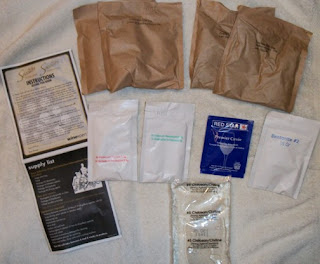I wasn't sure if I'd have anything interesting to say about filtering, after all, it's just filtering, right? Wrong.
About 7 or so liters in, I noticed that my filtering had really slowed down, and I was losing a lot of wine out of the drip tray, which I flow into my sink. I find the wine from the drip tray always tastes funny to me, so I choose not to keep it. Whether this is psychological or not remains to be seen, but we all have our quirks.
Nonetheless, I figured something was wrong with the filtration unit itself. It's second hand, and has been a little finicky from the start. Finally I wonderedif maybe the pads were clogged. I'd heard about this happening, but have never experienced it. Sure enough, they were coated with burgundy slime:
What the heck? This wine was clear, had sat for months....sigh. Insert new filter pads and keep going. After much toil, the wine was finally clear. The level of the wine, however, left much to be desired.
Prior to filtering, I had racked Jack to a primary, then back into the same carboy, so this is not a case of a different sized carboy. I had lost a substantial amount of wine down the sink.
So now I had a decision to make. Do I top up, wait the ten days as scheduled, or do I bottle sooner (to prevent spoilage) without topping up? There was a third, unappealing option of racking to a 5 gallon carboy and bottling the rest, but after fighting with the Mini jet that just sounded like a whole lot of work. I made the executive decision to bottle as soon as I could, and so about 48 hours later, bottled Jack.
And now at last, the taste test at the final bottling. I brought up a split each of the control and Tim from the cellar. Opened them, and decided to let them breathe for about half an hour.
First the swirl test. The control batch has lots of bubbles clinging to the side of the glass. Evidently not degassed enough. The other two have minimal bubbles.
Second, the smell test. The control batch smells quite strongly of that bubble gummy flavor affectionately known as "kit taste". Tim smells fairly hot, no other discernible smells. Jack also smells high alcohol, but there are some fruit notes coming through.
Third, taste. While the control batch smells "kit-y", the actual taste is not as bad as I would have thought. There's some oak and fruit back there, but at this stage the overall taste is still pretty thin. Tim tastes as hot as it smells, although there seem to be more tannins as well. I like tannin, so this is a good thing. Jack tastes pretty much like Tim.
My husband did a blind test of the three as well. His favorite was Tim, which he felt was still a little hot with a dry finish. His next choice was Jack, though he felt it was very hot with light tannin. Last choice for him was the control batch, which was somewhat hot, medium dry on the finish, and also light tannins. He felt that all of them exhibited red licorice notes.
So at present, I can draw no major conclusions, except that the longer time frames seem to produce a less gassy wine. Rather, I suspect that most kit wine makers likely bottle wines gassy if they bottle at the time specified on the direction. The wines that weren't gassy had much less "kit taste".
I'll be doing another taste test at the bench marks of one year, 18 months, and 2 years. And so now we wait....










